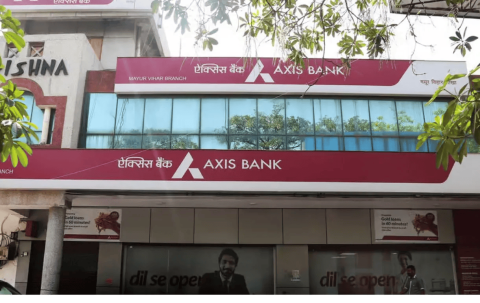Axis Bank Share Price Target at Rs 1,400: Emkay Research
Emkay Research has reiterated its BUY recommendation on Axis Bank, setting a 12-month target price of Rs 1,400, which represents a potential upside of 15.2% from the current market price of Rs 1,215. The report highlights Axis Bank’s robust operational and technological foundation, but also underscores the need for management stability and a more consistent growth trajectory to unlock further value. While the bank has navigated margin pressures better than most peers and boasts strong digital capabilities, its credit growth has been volatile and senior management attrition remains a concern. Investors are advised to monitor Axis Bank’s progress on growth acceleration and leadership stability, as these will be pivotal for future re-rating. The following analysis distills Emkay’s key findings and investment rationale.
Emkay Research’s Investment Thesis: BUY Axis Bank
Axis Bank remains a preferred pick for Emkay Research, with a BUY call and an unchanged target price of Rs 1,400, valuing the standalone bank at 1.7x FY27E Adjusted Book Value and subsidiaries at Rs 125 per share. The recommendation is anchored in the bank’s attractive valuations, operational resiliency, and medium-term growth prospects, despite near-term challenges in credit growth and management turnover.
Operational Resilience and Digital Leadership
Axis Bank has established a formidable technology, compliance, and risk management architecture, which has insulated it from regulatory and business disruptions that have affected its peers. The bank’s digital prowess is evidenced by superior app ratings—4.7 on Google Play and 4.8 on iOS—outperforming other large banks, which is expected to translate into enhanced customer experience and cross-selling opportunities.
The bank has also optimized its liability profile, reducing dependence on high-cost wholesale deposits and aligning its pricing with peers, leading to greater margin stability. The average interest rate duration of its portfolio stands at 15-18 months, complemented by a steady reduction in RIDF bonds and a strategic shift toward retail assets.
Margin Management Amidst Rate Volatility
Axis Bank has demonstrated superior margin management, with net interest margin (NIM) compression limited to just 8 basis points in FY25, compared to 10-40 basis points for other large banks (excluding HDFC Bank). The management expects the reported NIM to stabilize at approximately 3.8% in the medium term, down from 4% in FY25, as recent rate cuts by the RBI are likely to pressure margins in the first half of FY26, particularly in the second quarter.
However, liability repricing is anticipated to partially offset margin compression in the latter half of the year. This disciplined approach to margin management positions Axis Bank favorably relative to its peer set.
Credit Growth: Volatility and the Need for Acceleration
Despite a strong operational platform, Axis Bank’s credit growth trajectory has been volatile and consistently sub-par compared to peers. Senior management attrition at regular intervals has further exacerbated the challenge, impeding the bank’s ability to deliver a stable and superior growth trajectory.
For the medium-to-long term, management expects loan growth to outpace the system by 300-400 basis points, but has refrained from providing specific guidance for FY26. The next phase of re-rating for Axis Bank will hinge on its ability to accelerate growth and ensure leadership stability.
Asset Quality: Stress Easing but Provisions Remain Elevated
The peak stress in the credit card portfolio appears to be behind, but microfinance (MFI) and personal loan (PL) segments are expected to take another quarter or more to show meaningful improvement. Axis Bank’s prudent recognition and provisioning policy, especially for unsecured loans, is likely to keep loan loss provisions (LLP) elevated in the near term.
The bank has recently tweaked its stress recognition policy for settlement cases, which may impact credit costs in the short run, but management asserts that headline NPAs and LLP have largely peaked. No further unilateral policy changes are planned that could affect these metrics.
Financial Performance and Valuation Metrics
Axis Bank’s financial snapshot underscores its resilience and potential for value unlocking:
| Metric | FY25 | FY26E | FY27E | FY28E |
|---|---|---|---|---|
| Net Profit (Rs mn) | 263,734 | 280,437 | 318,218 | 375,105 |
| Loan Growth (%) | 7.8 | 9.7 | 13.0 | 15.0 |
| NIM (%) | 3.7 | 3.5 | 3.5 | 3.5 |
| Adj. EPS (Rs) | 85.1 | 90.5 | 102.7 | 121.1 |
| RoA (%) | 1.7 | 1.7 | 1.7 | 1.8 |
| RoE (%) | 15.9 | 14.5 | 14.3 | 14.6 |
| P/E (x) | 13.2 | 12.2 | 10.6 | 8.9 |
| P/ABV (x) | 2.0 | 1.7 | 1.4 | 1.2 |
Axis Bank trades at a significant discount to peers such as ICICI Bank, HDFC Bank, and Kotak Mahindra Bank on P/ABV multiples, primarily due to lower RoE, volatile growth, and management instability. This valuation gap presents an opportunity for investors, contingent on the bank’s ability to address its growth and leadership challenges.
Key Levels and Targets for Investors
Current Market Price (CMP): Rs 1,215
12-Month Target Price (TP): Rs 1,400
Upside Potential: 15.2%
52-Week Range: Rs 934 - Rs 1,340
Valuation Basis: 1.7x FY27E Adjusted Book Value (ABV) for the standalone bank; subsidiaries valued at Rs 125 per share
Investment Risks and Watch Points
Key risks to the thesis include:
Failure to accelerate credit growth or resolve management attrition could perpetuate the valuation gap with peers.
Prolonged margin pressure from further rate cuts or adverse liability repricing.
Delayed recovery in MFI and PL asset quality, resulting in elevated provisions for longer than anticipated.
Conclusion: Outlook and Investor Strategy
Axis Bank offers a compelling risk-reward profile at current valuations, with Emkay Research maintaining a BUY rating and a target of Rs 1,400. While near-term headwinds in credit growth and asset quality persist, the bank’s operational resilience, digital leadership, and prudent risk management provide a solid foundation for medium-term performance. Investors should monitor progress on growth acceleration and management stability, as these factors will be decisive for future re-rating and value creation.
